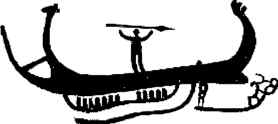Amleth/Hamlet
The story on which Hamlet is based was an ancient one; versions of it are found in Byzantine, Greek, and Roman myth*. The Danish story probably came to Shakespeare through an earlier play, now lost.
Rorik was real enough, a viking who (among other things*) was King of Jutland. But Rorik's grandson, Amleth, was a figure of legend rather than history, a heroic avenger who outsmarted his rivals and ended up with two wives. Rorik's daughter, Gerutha, was given in marrriage to his favourite, Horwendil, whose son was Amleth (Hamlet). . . and the legend begins.
The saga of Feng and Amleth
The original* story of Amleth is very similar to Shakespeare's play in broad outline: Feng murders his brother out of jealousy and marries Gerutha (Amleth's mother); Amleth pretends to be witless to save himself; his sanity is tested by the suspicious Feng*; he is sent to England guarded by two of Feng's retainers, who carry a death letter; Amleth alters the letter to order the deaths of the retainers and his own marriage to the King's daughter; he returns to Jutland and, after a celebratory feast, burns the Great Hall full of drunken nobles and murders his uncle, avenging his father.
Shakespeare's Hamlet does not pursue the story beyond this point. Read on for the tale Shakespeare left out*. . .
The source
Information on the historical and legendary background of Hamlet is derived primarily from Marion A. Taylor's A New Look at the Old Sources of Hamlet (1968).
Footnotes
-
Proto-Hamlet
The closest myth is Roman: the story of Junius Brutus, legendary founder of Rome, follows a similar pattern of murder and revenge. Brutus' father and brother are killed by his uncle Tarquin; Brutus feigns stupidity to save himself and ultimately overthrows the tyrant, founding the Roman republic. The Scandinavian name "Amleth" and the Latin "Brutus" both have the same meaning ("dull," or "foolish").
The Tarquins
In Roman tradition, the Tarquins were an Etruscan family that ruled Rome from ca.657 to ca.510 B.C. The revolt that deposed the last Tarquin was brought about by his son's rape of Lucrece and her subsequent suicide--a subject Shakespeare chose for a long narrative poem.
-
King Rorik
After the Treaty of Verdun (843) divided the Carolingian empire, Rorik lost his fiefdom and became, like many Norsemen, a scourge of Christendom--he raided Northern France (845) and in 850 looted the coasts of England with his fleet of 350 ships.
From Jutland, Rorik lead an expedition into Russia; there he settled in Novgorod, where the Slavs were in need of a strong ruler, and became (ca.860) the founder of an empire in Russia.
-
The original story
It is found in Belleforest's Histoires Tragiques (ca.1570), taken from Saxo Grammaticus's Historia Danica (ca.1180- 1208). Belleforest was not translated into English until 1608.
-
Feng tests Amleth
First he is tempted by a woman (the prototype of Ophelia), then spied upon while speaking alone with Gerutha (killing the eavesdropper, who was hiding in a pile of straw).
-
Hamlet, Part Two?
In the original, the tale continues: Amleth returns to England to fetch his wife, little knowing that her father had sworn to take revenge if Feng was murdered. The King sends Amleth as his proxy to woo the Scottish Queen Hermutrude (whose habit is to kill all her suitors).
But Hermutrude falls in love with Amleth and he takes her as a second wife. Amleth then slays his treacherous step-father and takes both his wives back to Jutland. There he finds his grandfather (Rorik) has died and the upstart Wiglek has stripped Gerutha of her wealth. After all his successful adventures Amleth is slain in battle by Wiglek.
Not much of the introspection, doubt, and intellectualizing of the anachronistic student from Wittenberg here.
